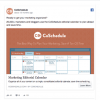While Google is still considered the king of PPC advertising, Facebook isn’t far behind. The popular social networking site has developed an incredibly advanced PPC platform that allows for specific targeting and powerful specialization. As we transition into a new year, it’s time for marketers to start focusing on how they can maximize the effectiveness of Facebook in modern PPC strategies.
Facebook: The Premier Advertising Network
When you look at digital marketing as a whole, there are a lot of moving parts. You’ve got online marketing, which is made up of SEO, SEM, content marketing, social media marketing, PPC advertising, affiliate marketing, and email marketing. Then you have the offline channels, which consist of radio marketing, TV marketing, phone marketing, electronic billboards, and more.
While each of these aspects is critical to the success of digital marketing, no platform exposes your brand to more people at a single time than social media marketing – specifically on Facebook.
And while Facebook has always been incredibly valuable to marketers, it’s possible that it could become even more important over the course of the next 12 months. If you want your digital marketing strategy to be complete in 2016, here are some helpful tips that should allow you to extract optimal value
- Begin Split Testing
One of the most useful developments in online advertising is the ability to conduct split tests for just about any aspect of a campaign. On Facebook, there are plenty of options for split testing. Using the same target audience, you can change something as simple as the image or ad copy and study the differences. In many cases you can increase your click through rate by multiple percentage points, while simultaneously decreasing your cost per action. For large campaigns, this can mean thousands of dollars saved.
- Utilize Custom Links
While Facebook provides advertisers with lots of data, it’s difficult to know what happens beyond Facebook if you don’t establish the right criteria. In order to fully understand how your ads perform, you’ll need to set up Google Analytics and create custom URLs for each ad you intend on posting. By doing this, you can better understand what’s happening after Facebook users click your ad and visit your website.
- Images Matter the Most
Facebook users always judge a book by the cover. In other words, they will not click on an advertisement if the image isn’t attractive or compelling. If there’s one thing you’re going to focus on, it should be using high quality and original images. You should avoid stock photos and develop fresh images that compel audiences to act. It should also be noted that Facebook has a 20 percent rule that says your ad must contain less than 20 percent text.
- Pay Close Attention to Location
One of the first ad targeting options a marketer learns how to use on Facebook is the location option. While it may seem pretty straightforward, did you know that selecting a location doesn’t always mean you’re targeting people who live there? There’s a small drop down menu that reads “Everyone in this location.” If you select this option, you’re literally targeting everyone in that location. However, there are other options, such as “People who live in this location,” “People recently in this location,” and “People traveling to this location.” Don’t overlook these options. They can have a big impact on the overall reach of your campaigns.
Start Leveraging Facebook
Google AdWords is a superb choice for those looking to invest in paid advertising, but don’t forget about Facebook. The fact that Facebook has access to so much data and user information means you can develop highly targeted campaigns that deliver maximum returns at relatively low costs. Keep these helpful tips in mind and you’ll be able to better leverage Facebook in the coming months.




